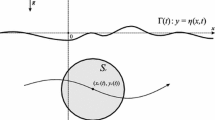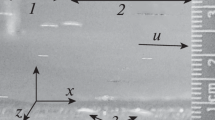Abstract
The initial stage of unsteady two-dimensional flow caused by the impulsive horizontal motion of a floating circular cylinder is investigated by using methods of asymptotic analysis. Initially the cylinder is half-submerged and the liquid free surface is flat and horizontal. The liquid is of infinite depth. Then the cylinder suddenly starts to move horizontally with a speed given as a function of time. The liquid is assumed ideal and incompressible and its flow potential. The initial flow is provided by pressure-impulse theory, with an account of a possible separation of the liquid free surface from the trailing face of the rigid surface of the cylinder. The initial position of the separation point on the surface of the moving body is determined by using the condition that the fluid velocity is finite at the separation point (Kutta condition). The motion of the separation point along the surface of the cylinder is numerically determined with the help of the second-order outer solution of the problem and the Kutta condition at the moving separation point. It is shown that the length of the wetted part of the cylinder surface increases at a rate proportional to the speed of the cylinder. The speed of the separation point depends on the Froude number. The pressure on the wetted part of the cylinder can be below the atmospheric pressure for relatively high speed.
Similar content being viewed by others
References
Sedov LI (1965) Two-dimensional problems of hydrodynamics and aerodynamics. Interscience Publications, New York
Kudryavtseva NA (1960) Horizontal impact of a floating ellipse on an incompressible fluid. Prikl Mat Mekh 24: 258–261
Korchagin VS (1978) Separation impact on a cylinder semi-submerged in a fluid. Izv Sev-Kavkaz Nauchn Tsentr Vyssh Shkoly Estestv Nauki 4: 25–27
Korchagin VS (1989) Separation impact of a body on an incompressible fluid. Izv Sev-Kavkaz Nauchn Tsentr Vyssh Shkoly Estestv Nauki 3: 30–33
Dvorak AV, Teselkin DA (1986) Numerical solution of two-dimensional problems of pulsed motion of floating bodies. Zh Vychisl Mat Mat Fiz 26(1): 144–150
Yudovich VI (2005) Unique solvability of the problem of separation impact of a solid on an inhomogeneous fluid. Vladikavkaz Mat Zh 7(3): 79–91
Norkin MV (2005) Methods of solving nonlinear problems of hydrodynamic impact in bounded regions. Fluid Dyn 40(4): 623–634
Lions JL (1971) Optimal control of systems governed by partial differential equations. Springer, New York
Norkin MV (2008) Separating impact on an elliptic cylinder floating on the surface of an ideal incompressible finite-depth. Fluid Dyn 43(1): 105–117
Norkin MV (2009) Separation impact of an elliptic cylinder floating on the surface of an inhomogeneous incompressible fluid. Izvestia Vusov Severo-Kavkazskii Region, Special Issue “Actual problems of mathematical hydrodynamics”. Nat Sci 168–173
Norkin MV (2009) Separation impact of a circular disk floating on the surface of an ideal incompressible fluid of infinite depth. J Appl Mech Tech Phys 50(4): 607–616
Galanov BA (1985) The method of boundary equations of the Hammerstein-type for contact problems of the theory of elasticity when the regions of contact are not known. J Appl Math Mech 49: 634–640
Galanov BA (1987) Nonlinear boundary equations for contact problems of the elasticity theory. Dokl Acad Nauk SSSR 296: 812–815
Aleksandrov VM, Pozharskii DA (1998) Nonclassical three dimensional problems of mechanics of contact interaction between elastic bodies. Faktorial, Moscow [in Russian]
Aleksandrov VM, Chebakov MI (2004) Analytical methods in contact problems of the elasticity theory. Fizmatlit, Moscow [in Russian]
Korobkin AA (1982) Formulation of penetration problem as a variational inequality. Dyn Sploshnoi Sredy 58: 73–79
Gazzola T, Korobkin AA, Malenica S (2006) Hydro-elastic Wagner impact using variational inequalities. In: Proceedings of 21th international workshop on water waves and floating bodies, Loughborough, UK, pp 57–60
Korobkin AA (1993) Low-pressure zones under a liquid–solid impact. In: Blake JR, Boulton-Stone JM, Thomas NH (eds) Bubble dynamics and interface phenomena: proceedings of the IUTAM symposium, held in Birmingham, UK, 6–9 September, 1993. Kluwer, Dordrecht, pp 375–381
Korobkin AA (2003) Cavitation in liquid impact problem. In: Proceedings of the 5th international congress on cavitation, Osaka, Japan, 6 pp
Needham DJ, Billingham J, King AC (2007) The initial development of a jet caused by fluid, body and free-surface interaction. Part 2. An impulsively moved plate. J Fluid Mech 578: 67–84
Korobkin AA, Iafrati A (2005) Hydrodynamic loads during initial stage of floating body impact. J Fluids Struct 21: 413–427
Author information
Authors and Affiliations
Corresponding author
Rights and permissions
About this article
Cite this article
Norkin, M., Korobkin, A. The motion of the free-surface separation point during the initial stage of horizontal impulsive displacement of a floating circular cylinder. J Eng Math 70, 239–254 (2011). https://doi.org/10.1007/s10665-010-9416-6
Received:
Accepted:
Published:
Issue Date:
DOI: https://doi.org/10.1007/s10665-010-9416-6




